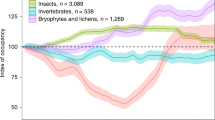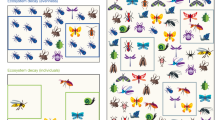Abstract
Ecologists would like to explain general patterns observed across multi-species communities, such as species–area1 and abundance–frequency relationships1,2,3,4, in terms of the fundamental processes of birth, death and migration underlying the dynamics of all constituent species. The unified neutral theory of biodiversity5,6 and related theories7,8 based on these fundamental population processes have successfully recreated general species-abundance patterns without accounting for either the variation among species and individuals or resource-releasing processes such as predation and disturbance, long emphasized in ecological theory9,10,11,12,13,14. If ecological communities can be described adequately without estimating variation in species and their interactions15, our understanding of ecological community organization and the predicted consequences of reduced biodiversity and environmental change would shift markedly. Here, I introduce a strong method to test the neutral theory that combines field parameterization of the underlying population dynamics with a field experiment, and apply it to a rocky intertidal community. Although the observed abundance–frequency distribution of the system follows that predicted by the neutral theory, the neutral theory predicts poorly the field experimental results, indicating an essential role for variation in species interactions.
This is a preview of subscription content, access via your institution
Access options
Subscribe to this journal
Receive 51 print issues and online access
$199.00 per year
only $3.90 per issue
Buy this article
- Purchase on Springer Link
- Instant access to full article PDF
Prices may be subject to local taxes which are calculated during checkout



Similar content being viewed by others
References
MacArthur, R. H. & Wilson, E. O. The Theory of Island Biogeography (Princeton Univ. Press, Princeton, 1969)
Fisher, R. A., Corbet, A. S. & Williams, C. B. The relation between the number of species and the number of individuals in a random sample of an animal population. J. Anim. Ecol. 12, 42–58 (1943)
Preston, F. W. The commonness, and rarity, of species. Ecology 41, 611–627 (1948)
Brown, J. H. Macroecology (Univ. Chicago Press, Chicago, 1995)
Hubbell, S. P. A unified theory of biogeography and relative species abundance and its application to tropical rain forests and coral reefs. Coral Reefs 16, S9–S21 (1997)
Hubbell, S. P. The Unified Theory of Biodiversity and Biogeography (Princeton Univ. Press, Princeton, 2001)
Caswell, H. Community structure: a neutral model analysis. Ecol. Monogr. 46, 327–354 (1976)
Bell, G. Neutral macroecology. Science 293, 2413–2418 (2001)
Elton, C. S. Animal Ecology (Sidgwick and Jackson, London, 1927)
Gause, G. F. The Struggle for Existence (Hafner, New York, 1934)
Hutchinson, G. E. Homage to Santa Rosalia or why are there so many kinds of animals? Am. Nat. 93, 145–159 (1959)
Huffaker, C. B. Experimental studies on predation: dispersion factors and predator-prey oscillations. Hilgardia 27, 343–383 (1958)
Paine, R. T. Food web complexity and species diversity. Am. Nat. 100, 65–75 (1966)
MacArthur, R. H. Geographical Ecology (Harper & Row, New York, 1972)
Laska, M. S. & Wootton, J. T. Theoretical concepts and empirical approaches to measuring interaction strength. Ecology 79, 461–476 (1998)
McGill, B. J. Strong and weak tests of macroecological theory. Oikos 102, 679–685 (2003)
Adler, P. B. Neutral models fail to reproduce observed species-area and species-time relationships in Kansas grasslands. Ecology 85, 1265–1272 (2004)
Connell, J. H. The influence of interspecific competition and other factors on the distribution of the barnacle Chthamalus stellatus. Ecology 42, 710–723 (1961)
Paine, R. T. Ecological determinism in the competition for space. Ecology 65, 1339–1348 (1984)
Wootton, J. T. Prediction in complex communities: analysis of empirically-derived Markov models. Ecology 82, 580–598 (2001)
Wootton, J. T. Markov chain models predict the consequences of experimental extinctions. Ecol. Lett. 7, 653–660 (2004)
Paine, R. T. Food-web analysis through field measurements of per capita interaction strength. Nature 355, 73–75 (1992)
Moore, J. C., de Ruiter, P. C. & Hunt, H. W. The influence of productivity on the stability of real and model ecosystems. Science 261, 906–908 (1993)
Rafaelli, D. G. & Hall, S. J. in Food Webs: Integration of Pattern and Dynamics (eds Polis, G. & Winemiller, K.) 185–191 (Chapman and Hall, New York, 1996)
Wootton, J. T. Estimates and tests of per-capita interaction strength: diet, abundance, and impact of intertidally foraging birds. Ecol. Monogr. 67, 45–64 (1997)
Kokkoris, G. D., Troumbis, A. Y. & Lawton, J. H. Patterns of species interaction strength in assembled theoretical competition communities. Ecol. Lett. 2, 70–74 (1999)
Drossel, B., McKane, A. & Quince, C. The impact of nonlinear functional responses on the long-term evolution of food web structure. J. Theor. Biol. 229, 539–548 (2004)
Acknowledgements
I thank the Makah Tribal Council for providing access to Tatoosh Island; J. Sheridan, J. Salamunovitch, F. Stevens, A. Miller, B. Scott, J. Chase, J. Shurin, K. Rose, L. Weis, R. Kordas, K. Edwards, M. Novak, J. Duke, J. Orcutt, K. Barnes, C. Neufeld and L. Weintraub for field assistance; and NSF, EPA (CISES) and the Andrew W. Mellon foundation for partial financial support.
Author information
Authors and Affiliations
Corresponding author
Ethics declarations
Competing interests
The author declares that he has no competing financial interests.
Rights and permissions
About this article
Cite this article
Wootton, J. Field parameterization and experimental test of the neutral theory of biodiversity. Nature 433, 309–312 (2005). https://doi.org/10.1038/nature03211
Received:
Accepted:
Issue Date:
DOI: https://doi.org/10.1038/nature03211
This article is cited by
-
Does God roll dice? Neutrality and determinism in evolutionary ecology
Biology & Philosophy (2019)
-
Successional convergence in experimentally disturbed intertidal communities
Oecologia (2018)
-
An experimental test on the probability of extinction of new genetic variants
Nature Communications (2013)
-
Is there an ecological basis for species abundance distributions?
Oecologia (2013)
-
Microbial interactions: from networks to models
Nature Reviews Microbiology (2012)
Comments
By submitting a comment you agree to abide by our Terms and Community Guidelines. If you find something abusive or that does not comply with our terms or guidelines please flag it as inappropriate.



